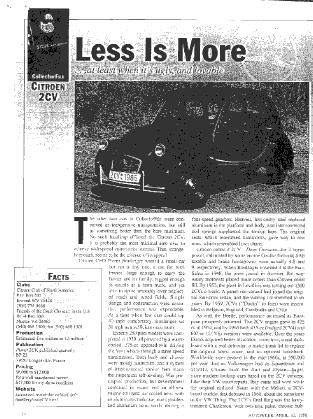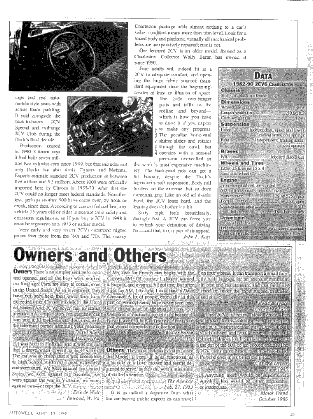.
The other two cars in CollectorFile were
conceived as inexpensive transportation, but still as something better than the bare
minimum.
No such handicap afflicted the Citroen 2CV.
It is probably the most minimal auto ever to achieve
widespread commercial success. but, strangely enough, seems to be the essence of its
appeal.
Citroen CEO Pierre Boulanger wanted a small car but not a tiny one; a car for rural
France, large enough to carry the farmer and his family, rugged enough to double as a farm
truck, and yet able to tiptoe smoothly over neglected roads and rutted fields. Simple
design and construction were essential, performance was expendable. At a time when few
cars could top 40 mph comfortably, Boulanger set 31 mph as a sufficient maximum.
Exactly 250 pilot models were completed in 1939, all powered by a water-cooled, 375-cc
opposed-twin driving the front wheels through a three-speed transmission. Both body and
chassis were mostly aluminum, and a system of interconnected torsion bars made the
suspension self-leveling. War preempted production, but development continued in secret,
and an all-new engine emerged: air-cooled now, with an aluminum crankcase, iron cylinders
and aluminum hemi heads, driving a four-speed gearbox. Heavier, less-costly steel replaced
aluminum in the platform and body, and interconnected coil springs supplanted the torsion
bars. The original seats, which resembled hammocks, gave way to new ones, which resembled
lawn chairs.
Citroen called it 2CV-Deux Chevaux-for 2 horsepower, calculated by some
arcane Gaullic formula; SAE taxable and brake horsepower were actually 4.8 and 9,
respectively. When Boulanger unveiled it at the Paris Salon in 1948, the press jeered in
derision. But warweary motorists placed more orders than Citroen could fill. By 1953, the
plant in Levallois was turning out 1500 2CVs a week. A panel-van variant had joined the
original four-door sedan, and the waiting list stretched to six years. By 1959, 2CVs
("Ducks" to fans) were assembled in Belgium, England, Cambodia and Chile.
As with the Beetle, performance increased as European prosperity returned. The 2CV engine
grew to 425 cc in 1954, and by 1965 both 435-cc (badged 2CV4) and 602-cc (2CV6) versions
were available. Over the years Ducks acquired better insulation, more trim, a real
dashboard with a real defroster, a metal trunk lid to replace the original fabric cover,
and an optional hatchback. Worldwide sales peaked in the mid-1960s, at 350,000 per year.
Just as Volkswagen had its Squareback and 411/412, Citroen built the Ami and Dyane-Larger,
more modern-looking cars based on the 2CV concept. Like their VW counterparts, they came
and went while the original endured. Same with the Mehari, a 2CVbased trucklet that
debuted in 1968, about the same time as the VW Thing. The 2CV's final fling was the
fancytrimmed Charleston, with two-tone paint, chrome hubcaps and real automobile-style
seats with actual foam padding.
It sold alongside the back-to-basics 2CV Special and midrange 2CV Club during the Duck's
final decade.
Production ceased in 1990. Citroen says', it had built seven million two-cylinder cars
since 1949, but that includes not only Ducks but also Amis, Dyanes and Meharis. Experts
estimate standard 2CV production at between five million and 5.5 million. About 1000 were
officially imported here by Citroen in 1955-70. After that the 2CV could no longer meet
federal standards. Nonetheless, perhaps another 500 have come over, by hook or crook,
since then. According to current federal law, any vehicle 25 years old or older is exempt
from safety and emissions regulations, so if you buy a 2CV in 1998 it must be registered
as a 1973 or earlier model.
Very early and very recent 2CVs command higher prices than those from the '60s and '70s.
The snazzy Charleston package adds almost nothing to a car's value; condition means more
than trim level. Look for a sound body and platform; virtually all mechanical problems are
inexpensively repaired; rust is not.
Our featured 2CV is an older model dressed as a Charleston. Collector Wally Baran has
owned it since 1990.
Four adults will indeed fit in a 2CV in adequate comfort, and opening the huge
fabric sunroof (standard equipment since the beginning) creates at least an illusion of
space.
The little two banger putts and trills to the redline. and beyond which is how you have to
drive it if you expect to make any progress. The peculiar horizontal LC shifter slides and
rotates hrough the cowl, but operates with a sensual precision unexcelled in the world's
most' expensive machinery. The' back-road ride can get a bit bouncy, despite the Duck's
legendarily soft suspension. Body rollborders on the extreme, but so does comering grip.
Like an, old solid-axle Ford, the 2CV leans hard, and the leaning doesn't bother it a bit
Sixty mph feels ' breathlessly, daringly fast A 2CV can force you to rethink your
definition of driving fun-and that too, is part, of its appeal.
-John F.Katz- |


